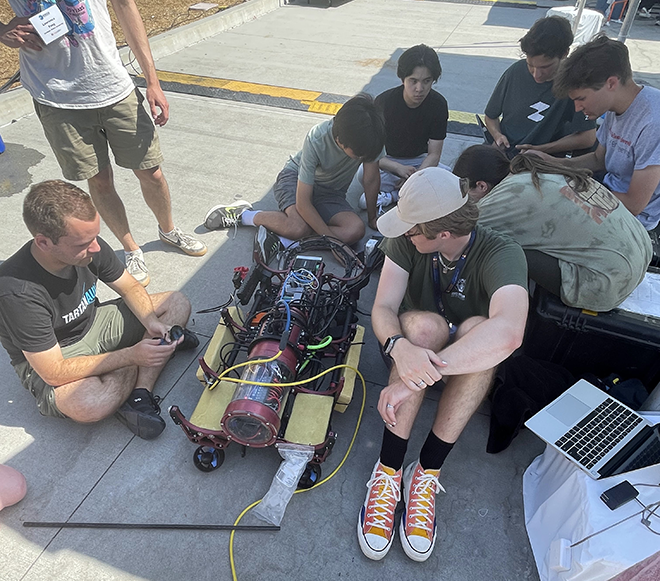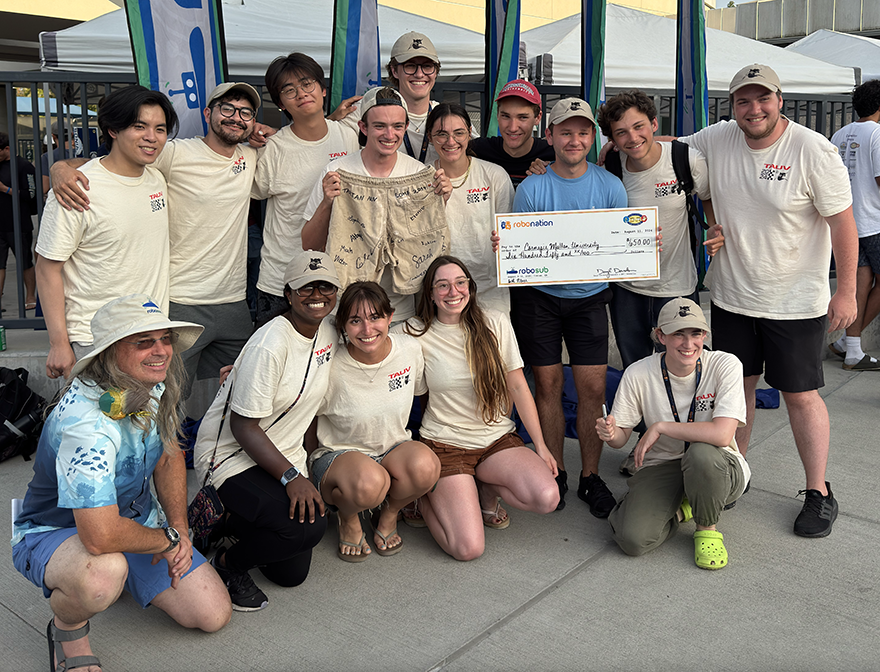Engineering beneath the surface
Students build an autonomous underwater vehicle that can perform tasks important to the maritime industry, including exploring, detecting, and manipulating objects and deploying projectiles underwater.
Sitting the edge of the pool, the Kingfisher, Carnegie Mellon University’s flagship autonomous underwater vehicle (AUV), looks more like a weapon in a sci-fi movie than a sophisticated robotic submarine that maneuvers underwater with grace and purpose.
The 80-pound Kingfisher was built by the TartanAUV team, a group of mostly undergraduate students from engineering and computer science, who have been competing in RoboSub competitions since 2018. RoboSub is an international underwater robotics contest where high school, college, and graduate students showcase their skills at designing and building AUVs.

Last summer the Tartan team hauled the four-foot-long Kingfisher to the Woollett Aquatics Center in Irvine, California, to compete in RoboSub 2024, where they placed sixth in the Autonomy Challenge.
Supported by RoboNation and the Office of Naval Research, the competition challenges contestants to build AUVs that perform tasks that are important to the maritime industry. During a series of trials, the robots demonstrate their capacity for exploring; detecting and manipulating objects; and deploying projectiles underwater.
“The tasks the subs complete are relatively simple to do above water, but when you’re underwater, there’s a host of different challenges. Underwater, we can’t use Wi-Fi. So how do you communicate with the sub? How do you tell it what to do? And then, how do you build something that does what you want? Building things to use underwater is a lot harder than building things for above water,” says Rylan Morgan, a senior in electrical and computer engineering and the lead for the electrical team. The student club has three technical divisions: electrical, mechanical, and software.
I have gained a lot of practical knowledge from RoboSub. Our team has become good friends, but the idea now is to pull more people into the group.
Rylan Morgan, Student, Electrical and Computer Engineering
“When it comes to the physical hardware design, mechanical and electrical have a lot of crosstalk because we are building the actual sub. And we communicate with the software group because we want to design and build something that they will code for,” says Morgan.
Determined to place at the 2024 competition, the team identified features of the Kingfisher that they could improve upon. Outlined in their “RoboSub 2024 Technical Design Report,” were revisions made to the sub. The most unique update to the robot was a sphincter intake mechanism that can go around an object and close itself onto it, making it a competent “grabber” for tasks like picking up game pieces. Other updates were made to the torpedo, torpedo launcher, and dropper. A dropper is a device that drops small objects at specific underwater locations.

Members of the TartanAUV team at RoboSub 2024
The team tested their sub in a tank down in the depths of Newell Simon Hall, and according to Morgan, they invested a lot into enhancing the testing infrastructure. With help from their sponsors, they were able to buy new equipment, like a thermal camera and a load generator. “We also got an extremely nice oscilloscope from Teledyne LeCroy,” says Morgan. Competing in RoboSub is expensive, and to support their efforts, the team includes students who manage finance and operations, and work to secure sponsors.
“I have gained a lot of practical knowledge from RoboSub. Our team has become good friends, but the idea now is to pull more people into the group,” says Morgan. While the students enjoy the social aspects of the club, there are also professional benefits. Through competing, the Navy interacts with the students and has access to their resumes.
“I think the Navy sees RoboSub as a way to see what students are coming up with, and they are finding talent and advancing the development of AUVs,” says Morgan.
